TONGJIUNIVERSITYPRESS

An Interest in a Garden Grows with Daily Visits
Chinese gardens, both picturesque and lyrical, distinguish themselves from other gardens in the world by successfully integrating architecture, paintings, calligraphy and literature with garden design.

Each classical Chinese garden has its own unique style. Yihe Garden (the Summer Palace) impresses visitors with Kunming Lake and Wanshou Hill (Longevity Hill); Beihai Park attracts visitors with the ripples on the lake and Qionghua Islet; Zhuozheng Garden in Suzhou is noted for its winding and misty streams and Geyuan Garden in Yangzhou for its precipitous yellow stone cliffs.
In designing a garden, it is desirable to take full advantage of the natural features of a location to save labor and materials; but it is more important to integrate these features with the garden itself. This is known as “to adapt your design to nature” in gardening.
Some Chinese gardens give priority to hills and some others to water. There are also gardens that emphasize hills with water as complementary scenery and gardens that highlight water with hills as supplementary views. Bodies of water are either gathered or distributed around the gardens while the hills look either plain or precipitous. Gardens excel in scenery and the scenery varies from garden to garden. Each of these gardens proclaims its own unique style. To appreciate them, visitors may take delight in having an in-position or inmotion view, that is, to view them from a fixed position or by simply wandering about. But while
6 中国园林如画如诗,集建筑、书 画、文学、园艺等艺术的精华,在世 界造园艺术中独树一帜。 每一个园都有自己的风格。游颐 和园,印象最深的应是昆明湖与万寿 山;游北海,则是湖面与琼华岛。苏 州拙政园曲折弥漫的水面、扬州个园 峻拔的黄石大假山等,都同样令人印 象深刻。 在造园时,如能利用天然的地形 再加人工的设计配合,不但可以节约 人工物力,而且利于景物的安排,造 园学上称之为“因地制宜”。
TONGJIUNIVERSITYPRESS
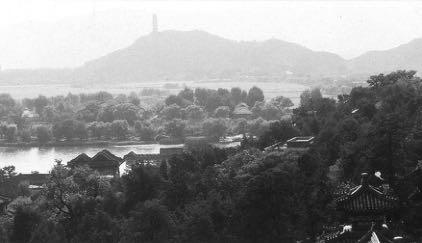

7 借景玉泉山 | Borrowing the scenery from Yuquan Hill 颐和园 | The Summer Palace 颐和园原为慈禧太后的夏宫。每到夏日,荷花盛放,衬以蓝天白云、 黄瓦红墙,一派辉煌气象。 The Summer Palace used to be a summer resort for Empress Dowager
It
in summer when lotus flowers
full
against the blue sky, yellow tiles and red walls. TONGJIUNIVERSITYPRESS
Cixi.
looks magnificently alluring
are in
blossom
Longevity Hill faces Kunming Lake with Foxiang Tower perched on the hill top. A huge complex of magnificent buildings along an ascending central axis remains the highlights of the Palace: Pailou (the Cermonial Gateway) at the foot of the hill, Paiyun Hall, Dehui Hall, Foxiang Tower and Zhihuihai Hall at the top of the hill.
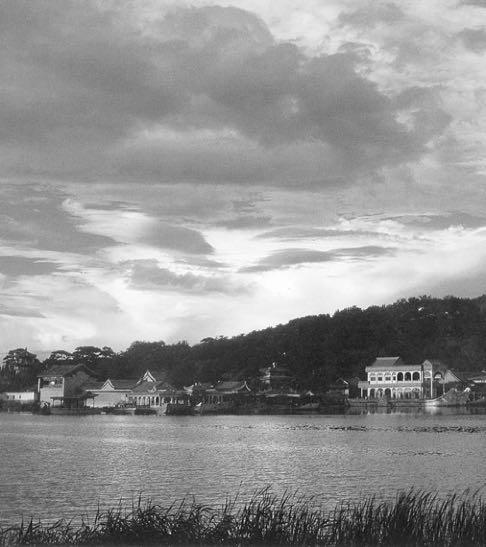
22 颐和园万寿山 | Longevity Hill in the Summer Palace 万寿山前临昆明湖,佛香阁高踞山巅。自山脚的牌楼经排云殿、德 辉殿、佛香阁,直至山顶的智慧海,形成一条层层上升的中轴线—— 这巨大的主体建筑群为全园的精华所在。
TONGJIUNIVERSITYPRESS
TONGJIUNIVERSITYPRESS

23
Haoshan Garden (Good Mountain Garden) following its further embellishment in the Ming Dynasty. In the forty-first year of the Kangxi reign (1702) in the Qing Dynasty, the garden became Wengshan Xinggong (Temporary Imperial Garden Residence). In the fifteenth year of the Qianlong reign (1750) in the Qing Dynasty, the garden residence was further expanded and renamed again as Qingyi Garden (Garden of Clear Ripples). Then in 1860, the garden was burnt down by the allied forces of the Great Britain and France. Twenty-six years later in 1886, the garden was reconstructed and given its modern name of Yihe Garden (Garden of Good Health and Harmony). Unfortunately it was destroyed again by the Eight-Power Allied Forces in 1900. Another reconstruction was completed in 1903 and has lasted to this day.
Meticulously imitating the landscape of the West lake in Hangzhou, the Summer Palace has a layout featured in Xidi (West Causeway), islets, misty willows and picturesque bridges, as if wearing the light make-up of China south of Changjiang River and the rouge of the north of China. The landscapes here reveal different tastes albeit their similarities.
The Summer Palace covers an area between three and four square kilometers, of which about three-fourths are covered by water, revealing its similarity to the landscape south of Changjiang River. Upon entering the eastern gate of the Palace, visitors may catch sight of Renshou Hall with its shooting cornices and precipitous stones in the front. Going round the hall to its southern end, visitors will be led unexpectedly into an open vastness of a clear lake.
24
颐和园在元代名“瓮山金海”, 至明代有所增饰,名“好山园”,清 康熙四十一年(1702)曾就此作瓮山 行宫。清乾隆十五年(1750)开始大 规模兴建,更名“清漪园”。1860 年 为英法联军所毁,1886 年修复,易名 “颐和园”,
皆移江南的淡妆,现北地之胭脂,景 虽有相同,趣则各异。 园面积达三四平方公里,水面占 四分之三,“北国江南”因水而成。 入东宫门,见仁寿殿,峻宇翚飞,峰 石罗前,绕其南豁然开朗,明湖在望。 万寿山面临昆明湖,佛香阁踞其 巅,八角四层,俨然为全园之中心。 TONGJIUNIVERSITYPRESS
1900 年又为八国联军所 破坏,1903 年又重修,遂成今状。 颐和园是以杭州西湖为蓝本,精 心模拟,故西堤、水岛、烟柳画桥,

25 十七拱桥上的石狮 | Stone lions on the Seventeen-Arch Bridge TONGJIUNIVERSITYPRESS
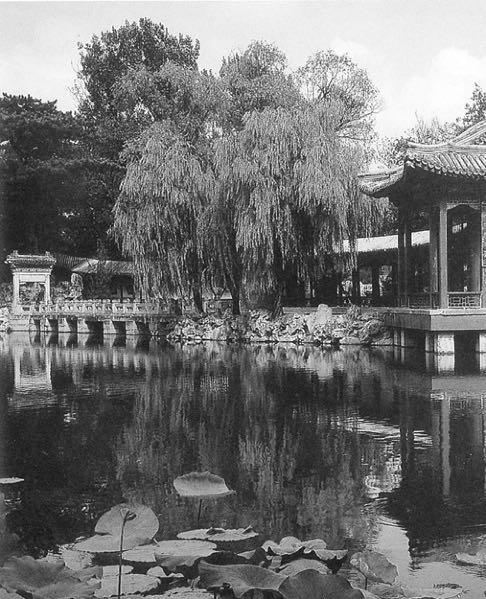
30 谐趣园 | Xiequ Garden 颐和园著名的“园中之园”,富有江南情趣。
“
Xiequ Garden, rich in features of gardens south of Changjiang River, is noted as the
garden inside gardens” of the Summer Palace. TONGJIUNIVERSITYPRESS
TONGJIUNIVERSITYPRESS

31
sounds of chanting in Sanskrit amid the morning bells and evening drumbeats. Wenjin Gallery, which is used to store books is located here. It has an entire collection of the Chinese classics called Siku Quanshu1. Seen from both the eastern and northern parts of the garden area, are the magnificent the Eight Outlying Temples, a superb example of borrowing the scenery by integrating scenes inside the garden area with those outside.
The resort, covering an area of 5.64 square kilometers, is the largest of all existing gardens. Its adaptation to the natural terrain of hills, flat areas, lakes and pools brings variety to its landscape. Trees and flowers are planted according to their nature: pines are placed in mountains, maples in valleys, willows by water and lotuses in lakes. Such scenic spots as the Valley of Pines and the Pond of Lotuses are named after the scenes in the garden. In the Garden of Ten-Thousand Trees, the dense elm woods provide soothing shade for visitors, who cannot help feeling carried away by the unearthly comfort of the cool breezes.
Bodies of water in Chinese gardens are typically gathered together; but lake and pools in Chengde Imperial Mountain Resort display a fine balance between being gathered and separated. Water flows from ravines through the water gate in the southeast part of Wenyan Garden into Wulie River. Islets, embankments and pavilions such as Ruyizhou Islet, Yuesejiangsheng, Zhijingyun Banks and Shuixin Pavilion in the lakes and pools divide the water naturally into the East Lake, Ruyizhou Lake, and Upper and Lower Lakes. With pavilions half-hidden in trees and rivers lined with weeping willows, the scenery evokes profound
38
梵音到耳,且建藏书楼文津阁,储《四 库全书》1 于此。园外,东北两面有 外八庙,为极好的借景,融园内、园 外之景为一。 山庄占地 5.64 平方公里,为现存 苑囿中最大。山庄自然地势,有山岳 平原与湖沼等,因地制宜,变化多端。 而林木栽植,各具特征:山多松,间 植枫 ;水边宜柳 ;湖中栽荷。园中“万 壑松风”“曲水荷香”皆因景而得名。 而万树园中,榆树成林,浓荫蔽日, 清风自来,有隔世之感。 中国苑囿之水,聚者为多,而避 暑山庄湖沼得聚分之妙,其水自各山 峪流下,东南经文园水门出,与武烈 河相接。湖沼之中,安排如意洲、月 色江声、芝径云堤、水心榭等洲、岛、 桥、堰,分隔成东湖、如意洲湖及上、 下湖区域。亭阁掩映,柳岸低迷 , 景 深委婉。而山泉、平湖之水自有动静 之分,故山麓有“暖流喧波”“云容 水态”“远近泉声”;入湖沼则“澄 TONGJIUNIVERSITYPRESS
and
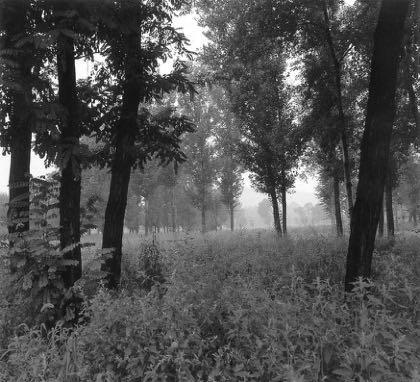
39 万树园 | Garden of Ten-Thousand Trees 在山庄平原区东北部。园内不施土木,按蒙古风俗设置蒙古包数座。 康熙、乾隆曾在此接见蒙古首领和西藏班禅六世等。 It lies in the northeast of the plain area in the Imperial Mountain Resort. There are no buildings except a few Mongolian yurts in this garden. Here Emperors Kangxi and Qianlong met the Mongolian leaders and the sixth Panchen Lama from Tibet. TONGJIUNIVERSITYPRESS
TONGJIUNIVERSITYPRESS

60 见山楼 | Jianshan
Tower
TONGJIUNIVERSITYPRESS

61
named Dianchun, meaning late spring, for Chinese herbaceous peonies don ’ t come into full bloom until late spring in contrast to other flowers that are in full blossom in spring. The pavilion consists of three partitions with a study where bamboos, rocks, plum trees and plantains are hidden behind windows, giving rise to an impression of paintings bathed in pale sunshine. The design of this garden surpasses that of all other gardens in Suzhou. Because the garden is small, buildings are ereted overhead to make the space seem much larger than it is. This intriguing application of “seeingthrough ” is revealed in details everwhere. For example, east of the pavilion is a rockery opposite zigzag covered walkways in the west. In the southeast lies the small, clear Hanbi Pool, which is connected to the large pond in the center of the garden, implying the source of the spring. A pavilion called Lengquan is above the spring. On its southern side are large steep rocks sparsely placed to form paired scenes with Dianchun Pavilion. The ground is covered with pebbles. The layout of this part follows the same garden design principle for the design of the pond in the center of the garden that is, to form a sharp contrast between water and land. The former design decorates water with rocks, while the latter one decorates rocks with water. On the whole, variable contrasts between buildings and rocks are used to present changing scenes to visitors.
It is difficult to make a large garden of a million mu compact, while it is equally hard to render a small garden of several mu as spacious. In a large but compact garden one does not feel tired when touring in it; in a small but spacious garden one feels as if there remains a lot to be seen. So when viewed in an in-position manner, i.e. at a standstill or in an in-motion manner, i.e.
70
甫诗所谓“名园依绿水”,正好为此 园写照。池周山石,看去平易近人, 蕴藉多姿,它的蓝本出自虎丘白莲池。 网师园西部殿春簃本来是栽植芍 药花的,因为一春花事,芍药开在最
泉”,南面略置峰石,为殿春簃的对景。 余地用卵石平整铺地。它与中部水池 同一原则,都是以大片面积,形成水 陆的对比。前者以石点水,后者以水 点石。在总体上,利用建筑与山石的 对比,相互更换,使人看去觉得变化 多端。 TONGJIUNIVERSITYPRESS
后,所以名为“殿春”。小轩三间, 复带书房,竹、石、梅、蕉隐于窗后, 每当微阳淡淡地照着时,宛如一幅浅 色的图画。苏州的园林,此园的构思 最佳。因为园小,建筑物处处凌虚, 空间扩大,“透”字的妙用,随处得之。 轩前面东为假山,与其西曲廊相对。 西南的角上有一小水池,名为“涵碧”, 清澈醒人,与中部大池有脉可通,存 “水贵有源”之意。泉上筑亭,名“冷

71 殿春簃内窗景 | Views through windows inside Dianchun Pavilion TONGJIUNIVERSITYPRESS

102 个园黄石山 | The
个园黄石山面西,以石和日照方位来显露秋意。 The
yellow stone rockery in Geyuan Garden
yellow stone rockery, facing the west, is indicative of the autumn with its stones and the slant of sunlight. TONGJIUNIVERSITYPRESS
TONGJIUNIVERSITYPRESS

103 个园冬山
| The rockery of winter in Geyuan Garden
displaced layers and delightful names are brought into the charming and colorful scenario, visitors find gardens being turned spacious on small plots of land, and buildings stylish out of simplistic designs.
Jiushishan Rocks in Xiaopangu Garden are among the best in gardens in Yangzhou. The compatible arrangement between buildings and rocks, between rocks and white-washed walls, between rocks and ponds, and between the front yard and the back yard contrasts the serene and open, and steep and plain matching techniques, resulting in an illusionary scenery of seemingly apart, but actually attached. The separating tracery walls are placed so flexibly and the piling of peaks, stone walls, step stones and valley mouths are so skillful that towering peaks amid soaring greens, grotesque rocks surrounded by oozing water are integrated into charmingly harmonious scenery. Although there do not exist any tall buildings or unique pavilions in the garden, it becomes stylish for its scenes being serene and deep, which is as good as a painting composed of just a few lines. “Less is more”, the principle guiding garden designs is best represented by this garden in Yangzhou.
Notes:
1. Jianzhen (688-763) was a monk of the Tang Dynasty. He attempted to visit Japan six times from 742 to 753. The last time, he successfully arrived in the southern part of Kyushu, Japan. Later he explained and publicized the Buddhist scriptures in Nara and founded the Tōshōdaiji Temple in 759.
2. Miscellany of Lüyuan Garden, written by Qian Yong in the Qing Dynasty, consists of twenty-four volumes, parts of which are on gardens in particular.
108
小盘谷的九狮山石壁尤为扬州园 林中之上选。园中的建筑物与山石、 山石与粉墙、山石与水池、前院与后 院等配置,利用了幽深与开朗、高峻 与低平等对比手法,形成一时间此分 彼合的幻景。花墙间隔得非常灵活, 山峦、石壁、步石、谷口等的叠置, 正是:危峰耸翠,苍岩临流,水石交 融,浑然一体。园内虽无高楼奇阁, 但幽曲多姿,浅画成图。“以少胜多” 的园林设计方法在扬州以此园最具有 代表性。 注释: 1. 鉴真(688 763), 唐代僧人。自 742 753 年间六 次东渡日本,最后一次成功抵达日本九州南部,后在 日本奈良宣讲佛经,759 年修建唐招提寺。 2.《履园丛话》,清钱泳撰,共二十四卷,其中有专 门记述园林的文字。
TONGJIUNIVERSITYPRESS


109 扬州小盘谷 | Xiaopangu Garden in Yangzhou 寄啸山庄福寿纹样铺地 | Decorative paving symbolic of happiness and longevity in Jixiao Mountain Resort
TONGJIUNIVERSITYPRESS

110 寄啸山庄水心亭 | Shuixin Pavilion in Jixiao Mountain Resort
TONGJIUNIVERSITYPRESS
TONGJIUNIVERSITYPRESS

111
and covered willow walkways with willows by the walkway. Walking through a covered walkway on a summer day, one feels the coolness brought by the green which disperse the summer heat. In winter when the sun shines through leaves, one finds the cozy warmth comforting. In ancient times a covered walkway could be used to display paintings, thus it was called a covered painting walkway, whereas today stone strips with poetic lines are embedded in the walls an excellent use of the covered walkway.
In a garden, bridges over water are just like covered walkways on land in their importance. Bridges commonly seen in gardens in Suzhou are girder bridges and are classified as straight bridges, bridges of nine turns, bridges of five turns, bridges of three turns and arched bridges. In terms of elevation, some bridges are level with the banks but above the water surface while others sink between the banks and float above the water; in terms of age, the latter are comparatively older such as those in Yipu Garden and Yiyuan Garden in Suzhou, Jichang Garden in Wuxi and gardens in Changshu. Two effect are achieved in these bridges. Firstly, when walking on a bridge that is level with the banks, one feels as if he is stepping on waves. The water seems more thrilling and the bridge really dangerous; secondly, a bridge lower than the banks emphasizes the sharp contrast in height between the bridge and their surrounding rockeries and buildings. An example is Jichang Garden in Wuxi where the rockery is heaped into a flat-topped hillock in front of the background scenery of Huishan Hill, and underneath in the secluded valley are contrasting bridges, all of which display the high standard of garden design in the Ming Dynasty. It is improper for contemporary girder bridges to be casually placed without giving proper considerations to the natural lie of the land nor to its size. Especially
130
园林中水面之有桥,正如陆路之 有廊,重要可知。苏州园林习见之桥, 一种为梁式石桥,可分直桥、九曲桥、 五曲桥、三曲桥及弧形桥等,其位置 有高于水面,与岸相平的,有低于两 岸,浮于水面的。以时代面论,后者 似较旧,苏州艺圃、怡园,无锡寄畅 园及常熟诸园所见的,都是如此。它 所表现的效果有二:第一,桥与水平, 则游者凌波而过,水益显汪洋,桥更 觉其危了; 第二,桥低,则山石、建 筑愈形高峻,与丘壑、高楼自然成强 烈对比。无锡寄畅园假山用平冈,其 后以惠山为借景,冈下幽谷间施以是 式桥,诚能发挥明代园林设计之高超 技术。今日梁式桥往往不照顾地形, 不考虑本身大小,随便安置,实属非 当,尤其栏杆之高度、形式,都要与 全桥及环境作一番研究才是。上选者, 如艺圃小桥、拙政园倚虹桥。拙政园 中部的三曲五曲之桥,栏杆比例还好, 可惜桥本身略高一些。待霜亭与雪香 云蔚亭二小山之间石桥仅搁一石板, 不施栏杆,极尽自然质朴之意,亦佳 TONGJIUNIVERSITYPRESS

131 南京瞻园 | Zhanyuan Garden in Nanjing 步石为桥,饶有野趣。 It is of wild fun to cross the stream over step stones. TONGJIUNIVERSITYPRESS
TONGJIUNIVERSITYPRESS
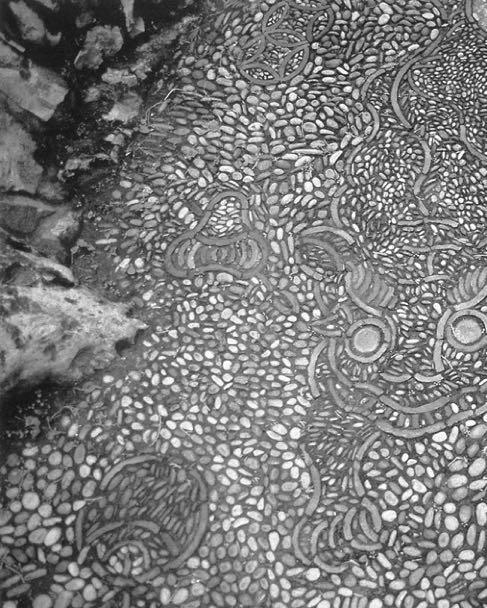
132 用瓦片卵石侧铺的北海静心斋铺地 |
The paving decorated with an animal made of edges of tiles and pebbles in Jingxin Chapel of Beihai Park
TONGJIUNIVERSITYPRESS
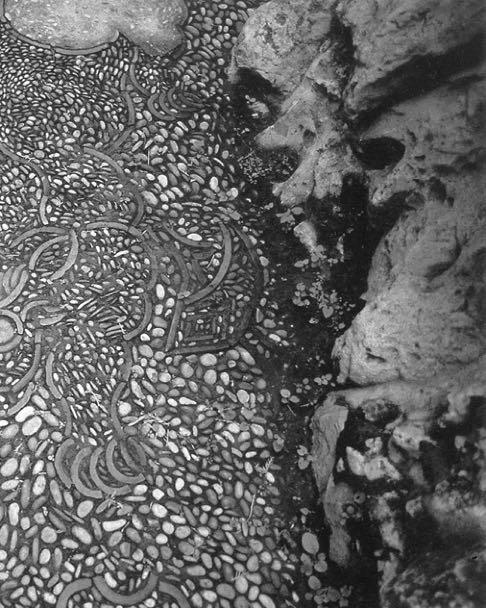
133
ideals materialized into the reality. All of these vistas are taken into consideration: the relationship of the shadows of flowers against white-washed walls; the sound of the wind blowing in through the pine trees; the ticktack sound of rain drops falling on lotus leaves; the brilliance of the moon illuminating the willow branches; the light of the setting sun perforating through lattice windows; and the year-end chill incapable of intimating the plum blossom and bamboos. Even the arrangement of a rock or tree is saturated with rich sentiments.
Notes:
1. Li Dou, a man of letters in the Qing Dynasty (dates of birth and death unidentified), was the author of Records of Pleasure Boats of Yangzhou which describes gardens in Yangzhou in a chapter.
2. Ni Zan (1301 or 1306-1374) was a great painter of the Yuan Dynasty who was good at painting landscapes. He described his paintings as being completed “ with free and casual strokes, and not restricted by shapes of objects ” and “ just to express my free mind ” . His painting style of “complexity embedded in simplicity” and “ sophistication embedded in immaturity ” has great influence upon the garden design.
3. Shen Zhou (1427-1509) was a painter of the Ming Dynasty. He was good at painting landscapes, especially mountains and water and gardens in China south of Changjiang River. Therefore, most of his paintings were completed with artistic motifs of gardens .
4. Landscape paintings were gaining popularity in the Tang Dynasty with leading painters such as Li Sixun and his son who painted landscapes in color and Wang Wei who developed a painting style of freehand brushwork and applying colors to paintings. In the Ming Dynasty , Dong Qichang advocated two schools for the classification of different styles in painting: a southern school and a northern school; and he was an ardent supporter of the southern school of freehand wash painting.
148
故有“松风听涛”“菰蒲闻雨”“月 移花影”“雾失楼台”等景致。造景 来达到这些效果,主要在于设计者有 高度的文学艺术修养,使理想中的境 界付之于实现,如对花影要考虑到粉 墙,听风要考虑到松,听雨要考虑到 荷叶,月色要考虑到柳梢,斜阳要考 虑到漏窗,岁寒要考虑到梅竹,等等。 安排一石一木,都寄托了丰富的情感, 使得处处有情,面面生意,含蓄曲折, 余味不尽。 注释: 1. 李斗,清代文人,生卒年不详,著有《扬州画舫录》, 其中有专章记述扬州园林的文字。 2. 倪 瓒(1301 或 1306 1374),元朝大画家,擅画 水墨山水,自谓“逸笔草草,不求形似”,“聊写胸 中逸气”。其“简中寓繁,似嫩实苍”的画风对造园 颇多启发。 3. 沈周(1427 1509),明朝画家,擅画山水,取景 江南山川和园林景物,其画多具园林意境。 4. 唐代,中国山水画开始盛行,有李思训父子着色山 水及王维的写意、渲染画风。至明代,董其昌始议分 南北二大宗派之说,并对南宗水墨写意推崇备至。
TONGJIUNIVERSITYPRESS

149 春到庭园 | Spring in the yard
TONGJIUNIVERSITYPRESS
图书在版编目(CIP)数据
中国名园 : 纪念版 = Famous Chinese Gardens (Centenary Edition) : 汉、英 / 陈从周著. -- 上海 :同济大学出版社, 2018.11 ISBN 978-7-5608-8170-6
①中… Ⅱ. ①陈… Ⅲ. ①古典园林-介绍-中国
Ⅳ. ①K928.73
版权所有 侵权必究 中国名园 陈从周 著 英文翻译:李梅 摄影:金宝源 何世尧 周祖贻 周仁德 廖启德 严丽娟 王文波 陈从周 封面摄影原作出自《圆明园》,三联书店香港分店/中国建筑工业出版社联合出版,1985 书名书法:陈从周 题字书法:乐峰 正文标题书法:勾愫痕 TONGJIUNIVERSITYPRESS
Ⅰ.
-汉、英
中国版本图书馆CIP数据核字(2018)第219597号 出版人 责任编辑 责任校对 装帧设计 出版发行 经销 印刷 开本 印张 字数 版次 书号 定价 华春荣 武蔚 罗璇 张德胜 博风建筑 同济大学出版社 http: //www.tongjipress.com.cn 地址:上海市四平路1239号 邮编:200092 电话:021-65985622 全国各地新华书店 上海雅昌艺术印刷有限公司 787mm×1092mm 1/16 9.5 237 000 2018年11月第1版 2018年11月第1次印刷 ISBN 978-7-5608-8170-6 65.00元 本书若有印装质量问题,请向本社发行部调换























